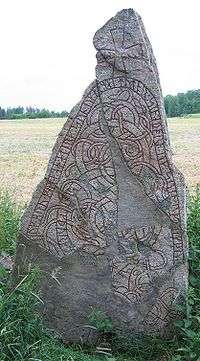Norsta Runestone
| Norsta Runestone | |
|---|---|
 | |
| Rundata ID | U 861 |
| Country | Sweden |
| Region | Uppland |
| City/Village | Norsta, Uppland |
| Produced | 11th century |
Text – Native | |
| Old Norse : See article | |
| Text – English | |
| See article | |
| Other resources | |
|
Runestones – Runic alphabet Runology – Runestone styles | |
The Norsta runestone is an 11th-century runestone inscribed in Old Norse with the Younger Futhark that stands near Wik Castle outside Uppsala, Sweden. It is notable because of the mention of two people named "maiden" and Sweyn. The form møy which appears on this runestone is the accusative form of Old East Norse māʀ which meant "maiden" and this is the only attestation of this word as the name of a girl, in Old Norse, besides a mention in the Hervarar saga, where a Mær ("maiden" in Old West Norse) married the Swedish king Inge I. Her brother was Blot-Sweyn, who succeeded Inge. As the runestone is from about the same time as Blot-Sweyn, it is likely that the Sweyn mentioned in the runestone is the same as the Swedish king Blot-Sweyn.
Transliteration
- sihikþurn ' ... [risa * stin] ' uk ' bru ' kera : at : aterf : sun : uk ' a(t) ' mai : tutor : sin : eþorn : uk : suen : uk ' (u)ikþu-... ' sikb--... ...(ʀ) ' isi
Transcription into Old Norse
- Sigþorn ... ræisa stæin ok bro gærva at Adiarf, sun, ok at Møy, dottur sina, Æiþorn ok Svæinn ok Vigþo[rn] ... ... <isi>
Translation in English
- Sigþorn ... the stone raised and the bridge made in memory of Ádjarfr, (his) son, and in memory of Mey, his daughter; Eiþorn and Sveinn and Vígþorn ..
Notes
Sources
- Sveriges runinskrifter (1922) by Erik Brate
- Rundata
This article is issued from Wikipedia - version of the 9/8/2016. The text is available under the Creative Commons Attribution/Share Alike but additional terms may apply for the media files.